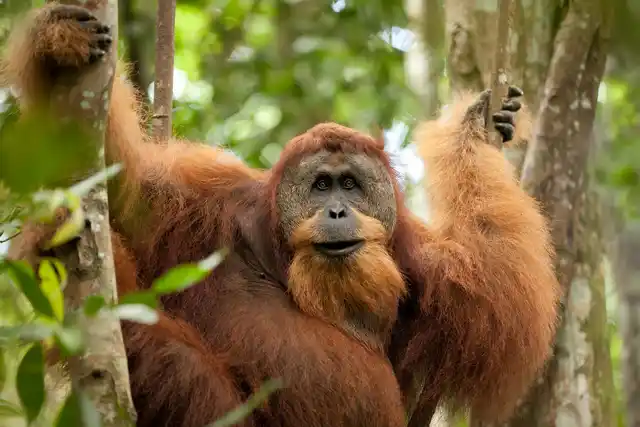Seeing Orangutans In the Wild
Seeing orangutans in the wild is one of the most magical experiences in Borneo. Starting early in the day, you set out into the jungle before the mist has risen. Trudging through wet soil, peeling back the bright green vegetation as you go, you venture into the wild to search for orangutans. At this time in the morning, these incredibly human-like creatures are setting out in search of breakfast, occasionally daring to come down to the forest floor to pick up fallen fruit. You may hear the odd hoot or call, but not the overwhelming chatter experienced when tracking chimpanzees.
It takes expertise and patience to find these mesmerising and peaceful animals in their natural habitat, but luckily you are with just the person. Your expert guide leads you in the right direction, and before you know it, you are looking straight up at one of these charismatic apes. At home in the treetops, they are comfortable sitting above you, feeding on fruit. They are often just as curious about you as you are about them. Throughout Borneo, there are various areas where you can track wild orangutans, including the incredible Danum Valley and via river safaris down the Kinabatangan.
Spotting orangutans in the wild can be hard work, but it is always worth it to see them in their natural habitat. We also give clients the opportunity to visit the Sepilok Rehabilitation Centre, where injured and orphaned orangutans are nursed back to health so they can be reintroduced into the wild. Seeing orangutans here may not match the thrill of spotting them in the wild, and we wouldn’t suggest it as an alternative, but the opportunity to see them in close proximity is not to be missed. Visiting the Centre will contribute to this vital conservation project and complement your encounters with wild orangutans.
Borneo is an untamed and exciting island, full of surprises and wonderful experiences for people of all ages. Here you can trek jungles, relax on beaches, dive in turquoise oceans and travel down wildlife-rich rivers. Big safari vehicles are unnecessary, as you can explore on foot, by bike or by boat, experiencing intimate wildlife encounters like no other. We have used the same guides in Borneo for years, simply because they are the best at what they do. They have expert local knowledge which they will share with you, teaching you all about your surroundings, from the topography and wildlife to the local peoples and cultures.







